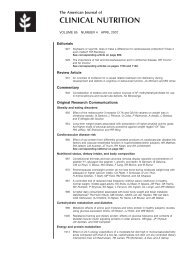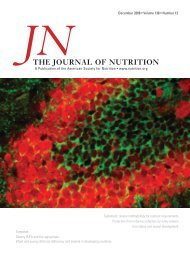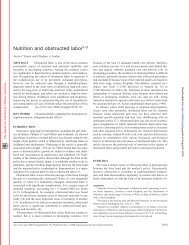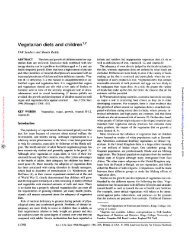Rice: a high or low glycemic index food?1'2 - American Journal of ...
Rice: a high or low glycemic index food?1'2 - American Journal of ...
Rice: a high or low glycemic index food?1'2 - American Journal of ...
Create successful ePaper yourself
Turn your PDF publications into a flip-book with our unique Google optimized e-Paper software.
GLYCEMIC INDEX OF RICE 1035<br />
TABLE 1<br />
The composition and weight <strong>of</strong>the <strong>food</strong>s<br />
Foods<br />
Protein<br />
(nitrogen X 6.25) Fat<br />
Carbohydrate<br />
by difference<br />
Weight <strong>of</strong> uncooked<br />
50-g carbohydrate<br />
p<strong>or</strong>tion<br />
Preparation<br />
% % % g<br />
Calrose white 5.7 0.5 79.9 62.6 Boiled f<strong>or</strong> 14 mm<br />
Calrose brown 6.6 2.7 75.6 66.1 Boiled f<strong>or</strong> 35 mm<br />
Pelde white 6.4 0.5 79.6 62.8 Boiled f<strong>or</strong> 14 mm<br />
Pelde brown 7.2 2.9 75.4 66.3 Boiled f<strong>or</strong> 30 mm<br />
Pelde (parboiled)5 7.0 1.0 79.4 63.0 Boiled f<strong>or</strong> 14 mm<br />
Doongara white (<strong>high</strong> amylose) 8.0 0.6 77.5 64.5 Boiled f<strong>or</strong> 14 mm<br />
Doongara brown (<strong>high</strong> amylose) 8.7 2.5 74. 1 67.5 Boiled f<strong>or</strong> 30 mm<br />
Sunbrown Quick 8.3 3.0 77.4 64.6 Boiled f<strong>or</strong> 16 mm<br />
Waxy rice (0-2% amylose) 7.3 0.8 77.2 64.8 Boiled f<strong>or</strong> 14 mm<br />
<strong>Rice</strong> cakes 8.0 2.7 8 1.5 6 1.3 Puffed product<br />
<strong>Rice</strong> bran 13.7 22.4 47.4 52.8t Pur#{233}ed with boiling<br />
water and flav<strong>or</strong>ing<br />
Brown rice pasta 8.9 2.6 75.5 66.2 Boiled f<strong>or</strong> 16 mm<br />
Wheat pasta 12. 1 0.2 75.9 65.9 Boiled f<strong>or</strong> 20 mm<br />
Rolled oats 8.9 9.7 68.8 72.7 Boiled f<strong>or</strong> 10 mm<br />
Rolled barley 7.5 2.4 76.9 65.0 Boiled f<strong>or</strong> 10 mm<br />
S Sungold: <strong>Rice</strong> Growers Cooperative Ltd. Leeton, NSW.<br />
t Weight <strong>of</strong> 25-g carbohydrate p<strong>or</strong>tion.<br />
by using the glucose hexokinase method on a Cobas-Fara centifugal<br />
analyzer (Roche Diagnostica, Basle, Switzerland) and insulin<br />
by radioimmunoassay with the Bio-RIA ‘25I-Insulin Chromacode<br />
Radioimmunoassay kit (Bio-Mega Diagnostica Inc.<br />
Hamon,<br />
Montreal).<br />
The GI and insulin <strong>index</strong> (II) <strong>of</strong> each <strong>food</strong> was calculated as<br />
described previously (3) by using a 50-g carbohydrate p<strong>or</strong>tion<br />
<strong>of</strong> white bread as the reference <strong>food</strong>. F<strong>or</strong> rice bran a 25-g carbohydrate<br />
p<strong>or</strong>tion was consumed and the incremental area under<br />
the curve was doubled. The GI was then multiplied by the fact<strong>or</strong><br />
70/ 100 to express the final result on a scale where glucose = 100.<br />
When glucose is used as the reference <strong>food</strong> the GI <strong>of</strong> bread is<br />
70 (2). The mean ± SE <strong>of</strong>eight subjects was calculated. In some<br />
instances, one <strong>or</strong> two subjects gave a GI <strong>or</strong> II outside two SDs<br />
from the mean <strong>of</strong> the group. Their results were excluded and<br />
the mean <strong>of</strong> the remaining subjects rep<strong>or</strong>ted. Comparisons between<br />
the <strong>food</strong>s were made by using two-way analysis <strong>of</strong> variance<br />
and the Bonferroni adjustment <strong>of</strong> the Student’s t test. Linearregression<br />
analysis was used to test f<strong>or</strong> an association between<br />
<strong>glycemic</strong> and insulin responses. The protocol was approved by<br />
the Medical Ethical Review Committee <strong>of</strong> the University <strong>of</strong><br />
Sydney and all subjects gave written, inf<strong>or</strong>med consent.<br />
Results<br />
The GI and II <strong>of</strong> the <strong>food</strong>s tested are shown in Table 2. The<br />
GIs <strong>of</strong> the white rices ranged from 64 ± 9 to 93 ± 1 1 . The rice<br />
with a <strong>high</strong>er amylose content (Doongara, 28% amylose) gave<br />
a significantly <strong>low</strong>er GI and II (P < 0.01) than did the n<strong>or</strong>malamylose<br />
rice varieties (Calrose and Pelde, 20% amylose). The<br />
waxy rice with 0-2% amylose had a GI similar to that <strong>of</strong> those<br />
containing n<strong>or</strong>mal amounts <strong>of</strong> amylose.<br />
The GIs <strong>of</strong> the brown rices were similar to their white counterparts<br />
except f<strong>or</strong> the Pelde variety. Pelde brown rice (GI = 76<br />
± 1 1) gave a significantly <strong>low</strong>er GI than did white Pelde (GI<br />
= 93 ± 1 1, P < 0.0 1). The parboiled (converted) Pelde rice gave<br />
a <strong>high</strong> GI (87 ± 7). Brown rice pasta and rice cakes gave <strong>high</strong><br />
GIs (92 ± 8 and 82 ± 1 1, respectively) whereas rice bran gave<br />
an extremely <strong>low</strong> GI ( 19 ± 3). The wheat pasta (GI = 58), rolled<br />
oats (GI = 58), and rolled barley (GI = 66) gave results that<br />
were similar to those rep<strong>or</strong>ted by others (3).<br />
TABLE 2<br />
The <strong>glycemic</strong> and insulin <strong>index</strong>es <strong>of</strong>the <strong>food</strong>s5<br />
Foods<br />
Glycemic <strong>index</strong><br />
(glucose = 100)<br />
Insulin <strong>index</strong><br />
(glucose = 100)<br />
Calrose white (n = 8) 83 ± 13 67 ± 15<br />
Calrose brown (n = 8) 87 ± 8 51 ± 7<br />
Pelde white (n = 7) 93 ± 1 1 67 ± 1 1<br />
Pelde brown (n = 8) 76 ± 6 55 ± 10<br />
Pelde (parboiled) (n = 8) 87 ± 7 57 ± 6<br />
Doongara white (<strong>high</strong><br />
amylose) (n = 8) 64 ± 9 40 ± 10<br />
Doongara brown (<strong>high</strong><br />
amylose) (n = 8) 66 ± 7 39 ± 6<br />
Sunbrown Quick (n = 8) 80 ± 7 54 ± 6<br />
Waxy rice<br />
(0-2% amylose)<br />
(11 = 7) 88 ± 11 89 ± 19<br />
<strong>Rice</strong> cakes (n = 6) 82 ± 1 1 73 ± 12<br />
<strong>Rice</strong> bran (n = 8) 19 ± 3 23 ± 4<br />
Brownricepasta(n=6) 92±8 72±18<br />
Wheat pasta (n = 6) 58 ± 7 52 ± 9<br />
Rolled oats (n = 7) 58 ± 4 54 ± 12<br />
Rolled barley (n = 8) 66 ± 5 64 ± 1 1<br />
S SE. The rice with a <strong>high</strong>er amylose content (Doongara, 28%<br />
amylose) gave a significantly <strong>low</strong>er <strong>glycemic</strong> <strong>index</strong> and insulin <strong>index</strong> (P<br />
< 0.0 1) than did the n<strong>or</strong>mal-amylose rice varieties (Calrose and Pelde,<br />
20% amylose).<br />
Downloaded from ajcn.nutrition.<strong>or</strong>g by guest on August 9, 2014









